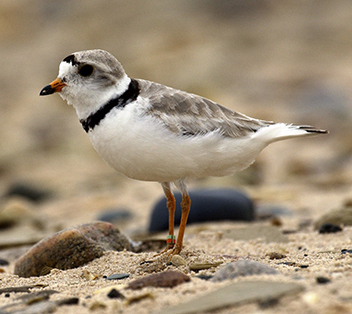Threatened and endangered species feature: piping plover
Piping plovers are special and beautiful birds – there are only 50-60 nesting pairs in the entire Great Lakes area and less than 7,000 individuals worldwide. Cryptically colored for a life among rocky and sandy soil, these birds can be distinguished from most other shorebirds by their black headband and the single black band around their neck. They may legitimately be described as “cute” throughout their lives.
The Great Lakes population of piping plovers is one of only three small populations in the U.S. During the winter all of these birds congregate on the Gulf Coast, but they travel to the separate areas during the breeding season. When it comes time to nest, piping plovers prefer gravelly beaches. Nests can be found on the Michigan shorelines of the Great Lakes, including Sleeping Bear Dunes National Lakeshore, from early April through mid-August.
 Disturbance can cause the birds to abandon their nests. Serious threats to these birds include dogs and careless off-road driving. Raccoons and raptors are common natural predators.
Disturbance can cause the birds to abandon their nests. Serious threats to these birds include dogs and careless off-road driving. Raccoons and raptors are common natural predators.
Both parents participate equally in incubating (sitting on) the eggs. When it is time to trade duties, one bird hops off and quickly runs away while the other scurries over and pops onto the nest, quite a comedic sight. Comedians and occasionally actors, piping plovers have a clever distraction tactic when threatened by a predator. Adult birds act as if their wing is broken and wobble and chirp to draw the predator away from their nest. Once the predator has been duped the bird flies off!
After safely making it through being in an egg, chicks hatch throughout the month of June. They are precocial – they can run about and feed themselves within hours of hatching. During the first week after hatching, chicks are unable to maintain their own body temperature and spend much time tucked in under their parents’ wings to keep warm. Within three to four weeks the chicks are able to fly.
The Great Lakes population of piping plovers is now endangered for two main reasons: habitat loss and predation. The beaches they require for nesting habitat are also very desirable to humans for development and recreational use. Staff members from the Department of Natural Resources, the U.S. Fish and Wildlife Service, and the National Park Service and volunteers work hard every year to observe and protect the nests of these rare birds. With intensive protection, the number of Great Lakes nesting plovers has risen from 17 pairs in 1986 to 58 pairs in 2012. The most popular place in Michigan to spot these elusive birds is Sleeping Bear Dunes. A pair of binoculars, patience and a good vantage point is all you need to see a piping plover.
Please help protect piping plovers:
- Observe and obey closed, fenced-in areas. Watch and enjoy plovers from a distance.
- Keep dogs and other pets on leashes and out of areas on the beach closed to pets.
- Don’t feed gulls or leave food on the beach. This increases the gull population and attracts predators that will also prey on piping plovers.
- If you find a plover family outside of the fencing, give them some space. The small chicks can disappear quickly in sand or cobble and are easily stepped on.
Additional ways to help include making a donation to the Nongame Wildlife Fund. Donations help to conserve Michigan’s wildlife resources and their habitats. Or consider purchasing a habitat license plate, where $25 of your $35 donation will be used to conserve wildlife habitat.
For more information on Michigan’s threatened and endangered species and the 40th-anniversary celebration, visit www.michigan.gov/wildlife.






